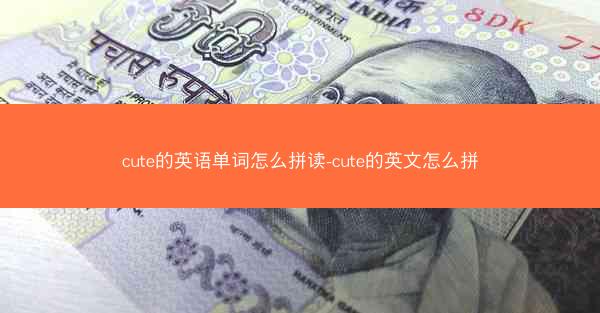cute的英语单词怎么拼读-cute的英文怎么拼

Unraveling the Enigma: The Spelling and Pronunciation of 'Cute'
In the vast tapestry of the English language, certain words weave themselves into our hearts with such ease that they become synonymous with joy and charm. One such word is cute, a term that can evoke a smile or a giggle with just a single syllable. But have you ever wondered how this little word is spelled and pronounced? Prepare to embark on a delightful linguistic journey as we delve into the mysteries of cute.\
The Spellbinding Alphabet: Deciphering 'Cute'
The word cute is a simple one, yet its spelling can be a bit deceptive. It is spelled with four letters: C, U, T, and E. The letter 'C' at the beginning is unremarkable, but it sets the stage for the enchanting 'U' that follows. The 'U' is pronounced as in you, not cup, which might confuse some. The 'T' is straightforward, as it is the same 'T' in table, and the final 'E' is silent, much like in knee.\
So, when you see cute, remember the sequence: C as in cat, U as in up, T as in top, and E as in knee. It's a simple dance of letters that, when strung together, create a word that can describe everything from a fluffy kitten to a charming outfit.
The Melodic韵律 of 'Cute'
Now that we've unraveled the spelling, let's turn our attention to the pronunciation. The word cute is pronounced with a soft, almost whimsical tone. The 'C' is silent, so you don't hear it when you say the word. The 'U' is elongated, as if you're stretching out the sound to capture the essence of cuteness. The 'T' is crisp and clear, and the 'E' is silent, adding to the word's endearing silence.
When you say cute, imagine a gentle breeze that whispers through the leaves, or a soft melody that plays in the background. The pronunciation should be light and airy, reflecting the word's inherent charm and playfulness.
The Evolution of 'Cute': A Historical Glimpse
The word cute has a rich history that dates back to the 17th century. It originated from the Middle French word cuet, which meant little or young. Over time, the word evolved and took on the meaning we associate with it today. It's fascinating to think that a word with such a simple origin has become a staple in our everyday vocabulary, used to describe everything from adorable animals to delightful moments.
The evolution of cute also reflects the changing perceptions of beauty and charm. In the past, cute might have been used to describe something small and delicate, but today, it encompasses a much broader range of meanings, often used to describe something that is charming, adorable, or appealing.
The Power of 'Cute': A Cultural Phenomenon
Cute is not just a word; it's a cultural phenomenon. It has become a part of our everyday language, used in everything from casual conversations to advertising campaigns. The word has the power to evoke emotions, to create connections, and to spread joy.
Consider the countless memes, social media posts, and advertisements that use cute to capture attention. Whether it's a picture of a kitten or a heartwarming moment, the word cute has the ability to make us stop and smile, to feel a sense of warmth and affection.
Conclusion: The Timeless Charm of 'Cute'
In the grand tapestry of the English language, cute is a thread that weaves through our lives, bringing moments of joy and wonder. Its simple spelling and melodic pronunciation make it a word that is easy to say and easy to love. Whether we're describing a fluffy puppy or a charming outfit, cute has the power to evoke a sense of delight and affection.
So, the next time you find yourself using the word cute, take a moment to appreciate its beauty. It's a small word with a big impact, a linguistic gem that continues to charm and enchant us all.
